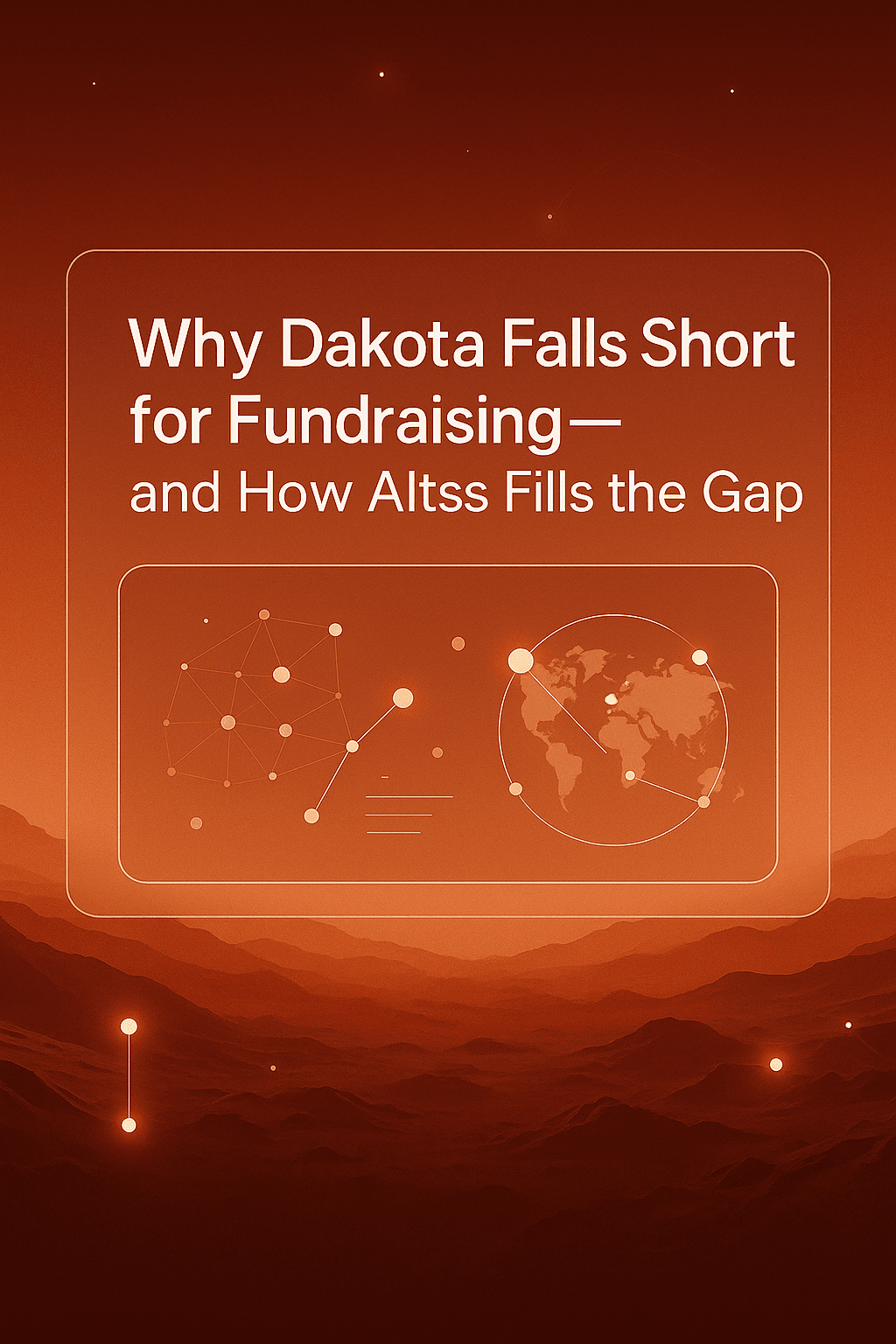Why Dakota Falls Short for Fundraising—and How Altss Fills the Gap
A strategic comparison of Dakota and Altss, revealing why Altss is the superior LP intelligence platform for emerging fund managers and IR teams in 2025. This article highlights gaps in mandate tracking, contact quality, and pricing transparency.

Why Dakota Falls Short for Fundraising—and How Altss Fills the Gap
Raising in 2025 is precision work. LPs are fully allocated, committees are cautious, and inboxes are hardened. What moves a raise isn’t “more contacts”—it’s fit, timing, and trust:
- Fit: Are you aligned with the LP’s current themes and check sizes?
- Timing: Are you engaging when their mandate or team is actually in motion?
- Trust: Do your data provenance and IR guardrails make diligence faster, not harder?
That’s the bar. Tools that merely list allocators won’t clear it. Dakota Marketplace—popular for U.S. allocator lists and a simple, CRM-like workflow—does parts of the job well. But for modern fundraising, it leaves critical gaps: mandate timing, family-office depth, verification rigor, and data governance that sophisticated LPs now expect. This article explains those gaps and shows how Altss—an OSINT-powered LP/GP intelligence layer—fills them with signal, evidence, and compliance-grade workflows.
What Dakota Gets Right (and Where It Breaks for 2025 Fundraising)
The good:
Dakota is straightforward to operate. For callers who need to assemble U.S. public-plan lists quickly, log notes, and track meetings, the interface feels familiar and fast. If your quarter is about phone volume into pensions, foundations/endowments, and consultants, the tool “gets out of the way” and lets your team dial.
The limits that matter now:
No live mandate timing.
Fundraising outcomes correlate with timing—vehicle openings, partner moves, strategy pivots, and visible event patterns. Dakota’s model is directory-first: profiles can read as static snapshots. That forces teams to do their own OSINT to figure out why now—which is where sprints stall.
Shallow family-office visibility.
Family offices remain the decisive swing capital for emerging managers, co-invests, and continuation vehicles. This is exactly where directories tend to be thinnest: lighter profiles, sparse context, inconsistent contacts, and limited preference tagging.
Contact quality and deliverability risk.
When verification relies mainly on manual refresh, bounce rates become your problem. And in 2025, domain reputation is a scarce asset. Unverified sends are costly—brand-wise and technically.
Workflow is sales-dialer, not IR.
Dakota’s strengths sit on list building and call tracking. But IR in 2025 is account-grade: two evidence points per first touch, quarterly snapshots that tie facts to narrative, and a documented posture on PII. You need a platform that helps you behave like a professional IR shop by default.
Cost model that grows with seats.
Per-seat/add-on pricing is fine for SDR teams; it’s less fine for lean GPs or placement agents who need everyone to see the same signal universe without buying incremental modules.
If your pipeline is U.S. public plans and your KPI is “meetings per caller,” Dakota will do the job. If your quarter depends on family offices, mandate timing, and evidence-led outreach, you’ll need more.
Altss: Intelligence That Turns Signals into Meetings
Altss in one line: An LP/GP intelligence layer built to convert signals → meetings → commitments with compliance-first guardrails.
What Altss changes for a raising team
1) Live signals, not static profiles.
Altss is OSINT-powered. It tracks visible change—vehicle activity, personnel moves, press mentions, event patterns—and expresses it as Signal Timelines and Fit & Timing Signals. Instead of “here’s a list of allocators,” you get “here’s why this LP is warm now.” That’s the difference between blasting and booking.
2) Family-office depth where others are thin.
Altss maintains 9,000+ verified family-office profiles across NA/EU/APAC, refreshed on a ≤30-day cadence. Profiles are built for operator-grade use: declared focus, check sizes, geography, and contextual clues that let you thread a thesis in the opener.
3) IR-grade verification and deliverability discipline.
Contacts are verified through multi-provider checks and bounce testing; teams that follow warm-up and sensible cadences routinely observe deliverability in the high-ninety range. No platform can guarantee zero bounces, but verification chains and sane sending behavior materially change reply rates.
4) Compliance by design (a diligence green-flag).
Altss is intentionally opinionated: no CSV/API export, selective client screening, and clearly separated treatment of business vs personal PII. In diligence, being able to say “we don’t dump raw PII” ends a whole category of concerns and puts the conversation back on your strategy.
5) A workflow built for fundraisers.
Fast filters, thesis-ready shortlists, and evidence surfaces that make a 90-second opener easy to write and defend. You don’t need ten widgets; you need two cited reasons and a credible next step.
Commercial posture: a single annual license at $15,500/year, set to pay back inside one fund cycle. Roadmap features align with outcomes—Events Radar (who will be where, matched to your list), GP–LP Connect and Warm-Path Finder (network intros you can act on), Relationship Graph (Q4 window), and forward Forecasts.
The IR Standard in 2025: What Sophisticated LPs Reward
Constraint-aware theses (operator math, not slogans).
“AI” doesn’t sell; AI infrastructure does—power availability, interconnect lead-times, land control, thermal constraints, and where you actually have an edge. Energy transition means grid bottlenecks, storage economics, and permitting cadence. If your platform doesn’t help you cite those in two sentences, it’s the wrong tool.
Timing as alpha.
Reply rates mirror committee calendars, vehicle launches, and senior-partner moves. Tools that surface that motion earn their keep in a single sprint.
Deliverability as moat.
The inbox is adversarial. Verified channels, respectful frequency, and evidence-led messages beat volume every time. A platform that treats verification as first-class will outperform “bigger list” bets.
Compliance as brand.
Export discipline and PII handling aren’t back-office headaches—they’re part of your LP trust story. Platforms that enforce good behavior help you win diligence before you start.
Altss was designed around these truths; Dakota was designed around dialing.
Three Vignettes (How the Gap Shows Up in Real Work)
Vignette 1 — Emerging GP, AI Infrastructure Thesis
Monday morning, the partner needs five FO meetings in two weeks. A directory produces a list; a signal-first system produces a reason: “This FO hired an infra lead in June, announced a digital-infrastructure sleeve in August, and two partners will be at the same conference next week.” The opener writes itself. Meetings get booked.
Vignette 2 — PE Platform + Add-On Roll-Up
A banker’s sponsor coverage team wants co-invest capacity. A dialer can give you consultants and pensions. Altss adds: “These four FOs have co-invest history in adjacent assets, and their Signal Timelines show two recent completions—prime time to pitch the next.” The path from signal to term sheet gets shorter.
Vignette 3 — Continuation Vehicle Readiness
The GP anticipates a GP-led transaction and needs a buy-side map. Directories list allocators; Altss shows allocators with visible appetite for CVs, plus timing cues (recent secondaries closes, team moves). The “why now” in the email reflects actual posture, not a guess.
A Buyer’s Checklist (No Tables—Just What to Ask)
Data model & freshness
- What is your refresh cadence for allocator profiles?
- How do you detect and express material change (vehicle, team, sector, event)?
Contact verification & deliverability
- Describe your verification chain. How do you manage bounces?
- Do you separate personal vs business channels and show that in the UI?
Mandate timing signals
- Show me ten named targets and what changed in the last 60 days—inside the product.
Workflow & governance
- Can my team create thesis-based shortlists with evidence attached?
- What are your guardrails on PII and exports?
Commercial clarity
- How many seats do I need for the people who actually do the work?
- What’s included, and what turns into add-ons later?
If your answers reveal that you’re buying a phone book, not a signals product, you know what to do.
30-Day Deployment Plan (Built to Prove ROI Fast)
Week 1 — Fit & Filters
Define the thesis buckets you’ll defend (AI infra; energy transition; secondaries; sector-specific growth). Lock check sizes and geos. Build a 40–60 name shortlist with high Fit & Timing.
Week 2 — Evidence-Led Openers
Attach two public signals to each target (vehicle movement, personnel change, event attendance, press). Write 90-second openers: why them, why now, your edge, single next step.
Week 3 — Trim and Fortify
Track replies and objections; prune segments that don’t convert. Add one-page operator memos to shore up constraints and underwriting posture.
Week 4 — Convert Signal to Meetings
Time follow-ups around events and committee windows. Send a two-page quarterly snapshot: Page 1 facts (pacing, realized/unrealized, pipeline, risks). Page 2 narrative (what changed, actions taken, specific asks—co-invest pre-clear, references, intros).
KPIs that matter
- ≥25% first-meeting rate from qualified targets
- High-single to low-double-digit reply rates on evidence-led opens
- Diligence cycles shortened by weeks because reporting and PII answers are crisp
Objections You’ll Hear—And Credible Responses
“Dakota already covers our universe.”
Coverage isn’t conviction. Show me what changed for my top 25 targets in the last 60 days and how you verified current contactability. If the answer is “we export and research manually,” you don’t have mandate timing—you have latency.
“We need CSVs for our CRM.”
Do you need CSVs, or do you need outcomes? Export discipline is now a diligence question. Evidence-led workflows beat spreadsheet sprawl, and guardrails protect your brand and domain reputation.
“We’re institution-first; family offices are optional.”
Until committee calendars slip and a family office writes the decisive check. Institutional benchmarking and FO timing are complements, not substitutes.
The Plain-English Verdict
Dakota lists. Altss helps you raise.
If your platform shows who exists but not who’s moving, you will do more work for less signal. Dakota remains useful when your quarter is dial-heavy into U.S. public plans. But if your raise depends on family offices, mandate timing, and evidence-led outreach, Altss is the system that actually compresses time-to-meeting—with verification and governance that make sophisticated LPs comfortable.
Altss in one paragraph:
An OSINT-powered LP/GP intelligence layer with 9,000+ verified family-office profiles refreshed on a ≤30-day cadence, Signal Timelines and Fit & Timing Signals that explain why now, IR-grade verification that protects deliverability, and compliance-first guardrails (no CSV/API export, selective access, clear PII handling). A single license ($15,500/year) designed to pay back inside one fund cycle. A roadmap that mirrors real fundraising moments: Events Radar, GP–LP Connect, Warm-Path Finder, Relationship Graph, and forward Forecasts.
If your next 20 meetings decide your year, choose the platform built to deliver them.
Related articles

10 Ways Altss Outperforms Legacy Family Office Databases in 2025
The family-office market has outgrown legacy databases. This article breaks down 10 ways Altss outperforms traditional providers—global-first coverage, real-time OSINT, verified decision-maker contacts, advanced AI search, proactive data maintenance, and transparent pricing—so fundraisers can target UHNW families with precision, timing, and context that static lists can’t deliver.

Altss vs PitchBook vs Preqin vs Dakota: Which LP Database Wins in 2025?
This deep-dive report compares the top LP and investor intelligence platforms—Altss, PitchBook, Preqin, and Dakota—across LP relationship data, mandate tracking, contact freshness, real-time signal discovery, and strategic fundraising capabilities. It reveals why Altss leads in 2025 for IR professionals, emerging GPs, and capital formation leads.